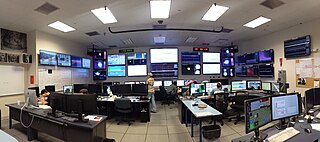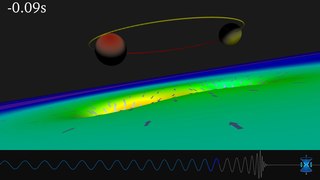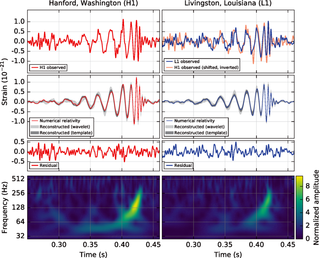Related Research Articles
In theories of quantum gravity, the graviton is the hypothetical quantum of gravity, an elementary particle that mediates the force of gravitational interaction. There is no complete quantum field theory of gravitons due to an outstanding mathematical problem with renormalization in general relativity. In string theory, believed by some to be a consistent theory of quantum gravity, the graviton is a massless state of a fundamental string.

The Laser Interferometer Gravitational-Wave Observatory (LIGO) is a large-scale physics experiment and observatory designed to detect cosmic gravitational waves and to develop gravitational-wave observations as an astronomical tool. Two large observatories were built in the United States with the aim of detecting gravitational waves by laser interferometry. These observatories use mirrors spaced four kilometers apart to measure changes in length—over an effective span of 1120 km—of less than one ten-thousandth the charge diameter of a proton.

Einstein@Home is a volunteer computing project that searches for signals from spinning neutron stars in data from gravitational-wave detectors, from large radio telescopes, and from a gamma-ray telescope. Neutron stars are detected by their pulsed radio and gamma-ray emission as radio and/or gamma-ray pulsars. They also might be observable as continuous gravitational wave sources if they are rapidly spinning and non-axisymmetrically deformed. The project was officially launched on 19 February 2005 as part of the American Physical Society's contribution to the World Year of Physics 2005 event.

GEO600 is a gravitational wave detector located near Sarstedt, a town 20 kilometres (12 mi) to the south of Hanover, Germany. It is designed and operated by scientists from the Max Planck Institute for Gravitational Physics, Max Planck Institute of Quantum Optics and the Leibniz Universität Hannover, along with University of Glasgow, University of Birmingham and Cardiff University in the United Kingdom, and is funded by the Max Planck Society and the Science and Technology Facilities Council (STFC).

The gravitational wave background is a random background of gravitational waves permeating the Universe, which is detectable by gravitational-wave experiments, like pulsar timing arrays. The signal may be intrinsically random, like from stochastic processes in the early Universe, or may be produced by an incoherent superposition of a large number of weak independent unresolved gravitational-wave sources, like supermassive black-hole binaries. Detecting the gravitational wave background can provide information that is inaccessible by any other means about astrophysical source population, like hypothetical ancient supermassive black-hole binaries, and early Universe processes, like hypothetical primordial inflation and cosmic strings.

The Virgo interferometer is a large-scale instrument for detecting gravitational waves. It is in Santo Stefano a Macerata, near the city of Pisa, Italy. The detector – a Michelson interferometer – has two arms that are 3 kilometres (1.9 mi) long and contain its mirrors and instrumentation in an ultra-high vacuum.

Gravitational waves are transient displacements in a gravitational field – generated by the relative motion of gravitating masses – that radiate outward from their source at the speed of light. They were first proposed by Oliver Heaviside in 1893 and then later by Henri Poincaré in 1905 as the gravitational equivalent of electromagnetic waves. In 1916, Albert Einstein demonstrated that gravitational waves result from his general theory of relativity as ripples in spacetime.

A gravitational-wave detector is any device designed to measure tiny distortions of spacetime called gravitational waves. Since the 1960s, various kinds of gravitational-wave detectors have been built and constantly improved. The present-day generation of laser interferometers has reached the necessary sensitivity to detect gravitational waves from astronomical sources, thus forming the primary tool of gravitational-wave astronomy.

Gravitational-wave astronomy is a subfield of astronomy concerned with the detection and study of gravitational waves emitted by astrophysical sources.
Within quantum technology, a quantum sensor utilizes properties of quantum mechanics, such as quantum entanglement, quantum interference, and quantum state squeezing, which have optimized precision and beat current limits in sensor technology. The field of quantum sensing deals with the design and engineering of quantum sources and quantum measurements that are able to beat the performance of any classical strategy in a number of technological applications. This can be done with photonic systems or solid state systems.

Alessandra Buonanno is an Italian-American theoretical physicist and director at the Max Planck Institute for Gravitational Physics in Potsdam. She is the head of the "Astrophysical and Cosmological Relativity" department. She holds a research professorship at the University of Maryland, College Park, and honorary professorships at the Humboldt University in Berlin, and the University of Potsdam. She is a leading member of the LIGO Scientific Collaboration, which observed gravitational waves from a binary black-hole merger in 2015.

In cosmology, primordial black holes (PBHs) are hypothetical black holes that formed soon after the Big Bang. In the inflationary era and early radiation-dominated universe, extremely dense pockets of subatomic matter may have been tightly packed to the point of gravitational collapse, creating primordial black holes without the supernova compression typically needed to make black holes today. Because the creation of primordial black holes would pre-date the first stars, they are not limited to the narrow mass range of stellar black holes.

The first direct observation of gravitational waves was made on 14 September 2015 and was announced by the LIGO and Virgo collaborations on 11 February 2016. Previously, gravitational waves had been inferred only indirectly, via their effect on the timing of pulsars in binary star systems. The waveform, detected by both LIGO observatories, matched the predictions of general relativity for a gravitational wave emanating from the inward spiral and merger of two black holes and the subsequent ringdown of a single, 62 M☉ black hole remnant. The signal was named GW150914. It was also the first observation of a binary black hole merger, demonstrating both the existence of binary stellar-mass black hole systems and the fact that such mergers could occur within the current age of the universe.

James E. Brau is an American physicist at the University of Oregon (UO) who conducts research on elementary particles and fields. He founded the Oregon experimental high energy physics group in 1988 and served as director of the UO Center for High Energy Physics from 1997 to 2016. Prior to joining the Oregon faculty, he served in the Air Force and held positions at the Stanford Linear Accelerator Center and the University of Tennessee. He is a fellow of both the American Physical Society and also the American Association for the Advancement of Science. In 2006 he was appointed the Philip H. Knight Professor of Natural Science, an endowed professorship.

GW170817 was a gravitational wave (GW) signal observed by the LIGO and Virgo detectors on 17 August 2017, originating from the shell elliptical galaxy NGC 4993, about 140 million light years away. The signal was produced by the last moments of the inspiral process of a binary pair of neutron stars, ending with their merger. It was the first GW detection to be correlated with any electromagnetic observation. Unlike the five previous GW detections—which were of merging black holes and thus not expected to have detectable electromagnetic signals—the aftermath of this merger was seen across the electromagnetic spectrum by 70 observatories on 7 continents and in space, marking a significant breakthrough for multi-messenger astronomy. The discovery and subsequent observations of GW170817 were given the Breakthrough of the Year award for 2017 by the journal Science.
David M. Strom is an experimental high energy particle physicist on the faculty of the University of Oregon.

Rana X. Adhikari is an American experimental physicist. He is a professor of physics at the California Institute of Technology (Caltech) and an associate faculty member of the International Centre for Theoretical Sciences of Tata Institute of Fundamental Research (ICTS-TIFR).
Lisa Barsotti is a research scientist at the Massachusetts Institute of Technology Kavli Institute.
Ground-based interferometric gravitational-wave search refers to the use of extremely large interferometers built on the ground to passively detect gravitational wave events from throughout the cosmos. Most recorded gravitational wave observations have been made using this technique; the first detection, revealing the merger of two black holes, was made in 2015 by the LIGO sites.
References
- ↑ "U.S., Index to Public Records, 1994-2019" . www.ancestry.com. September 11, 2022.
- ↑ Schofield, Robert M. S. (1990). X-Ray Microanalytic Concentration Measurements in Unsectioned Specimens: a Technique and its Application to Zinc, Manganese, and Iron Enriched Mechanical Structures of Organisms from Three Phyla (Thesis). Bibcode:1990PhDT.......283S. S2CID 135472065.
- 1 2 "Two UO scientists named fellows of American Physical Society". Around the O. December 16, 2014. Retrieved September 7, 2022.
- ↑ "2020 Faculty Promotions | Office of the Provost". provost.uoregon.edu. Retrieved September 17, 2022.
- ↑ "Research Staff | Profile Categories | Department of Physics". physics.uoregon.edu. Retrieved September 8, 2022.
- ↑ "Robert Schofield's research in The Conversation | Institute for Fundamental Science". ifs.uoregon.edu. Retrieved September 8, 2022.
- 1 2 3 Doughton, Sandi (May 14, 2018). "Ripples in space-time or 3-pound bird? Ravens at Hanford foul test of Einstein's theory". The Seattle Times . Retrieved September 17, 2022.
- ↑ Berti, Emanuele (2016). "The First Sounds of Merging Black Holes". Physics. 9: 17. arXiv: 1602.04476 . Bibcode:2016PhyOJ...9...17B. doi: 10.1103/Physics.9.17 . S2CID 54655094.
- ↑ "New research effort shines more light on black hole collisions". Around the O. December 1, 2021. Retrieved September 17, 2022.
- 1 2 "APS Fellow Archive". www.aps.org. Retrieved September 7, 2022.
- ↑ Brennard, Ema (January 7, 2011). "Leaf-cutter ants' teeth wear out". British Broadcasting Corporation. Retrieved November 18, 2022.
- ↑ Cooper, Matt (July 9, 2013). "Physicist finds new world with leaf-cutter ants". Around the O. Retrieved November 18, 2022.
- ↑ Garrett, Ryan W.; Carlson, Katherine A.; Goggans, Matthew Scott; Nesson, Michael H.; Shepard, Christopher A.; Schofield, Robert M. S. (2016). "Leaf processing behaviour in Atta leafcutter ants: 90% of leaf cutting takes place inside the nest, and ants select pieces that require less cutting". Royal Society Open Science. 3 (1): 150111. Bibcode:2016RSOS....350111G. doi:10.1098/rsos.150111. PMC 4736916 . PMID 26909161.
- ↑ "Skilled workers: Study shows the talents of leafcutter ants". Around the O. January 28, 2016. Retrieved September 8, 2022.
- ↑ Barlow, Jim (September 2, 2021). "Special materials boost the bite power of small critters". Around the O. Retrieved September 18, 2022.
- ↑ "McNair Scholars | Undergraduate Research and Distinguished Scholarships". urds.uoregon.edu. Retrieved November 18, 2022.
- ↑ "Seven faculty members earn 2017 Research Excellence Awards". Around the O. May 23, 2017. Retrieved September 17, 2022.